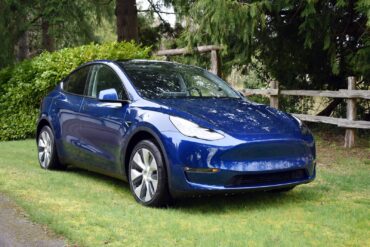
If you are expecting a dialogue bashing the internal combustion vehicle or touting the electric vehicles as the savior of our planet, I’m afraid you are in for a disappointment. My decision to purchase an EV was purely a matter of convenience and wanting to have more time to maintain my other six vehicles, which are gas-powered. My goal for this article is to provide an objective review of what my spouse, Val, and I have learned after owing a Tesla Model Y for a year.
Tesla introduced the Model 3 in 2017. It was Elon Musk’s version of the Model T, a lower-cost electric vehicle (compared to the previous Model S and X) for the masses. He followed this with a crossover SUV version in 2020.
Fate lends a hand as we ventured over to Lynnwood for a test drive. If you’ve never driven one of Elon’s creations, you are in for a pleasant surprise. One test drive and I was ready to order. At that time, Tesla Model Y orders were taking six to eight weeks for delivery (currently, I have been told people are waiting 12 months or more).
When I received notice (the Tesla folks don’t do phones, it’s just the way they roll) that our car would be available four days after we ordered it, I was simply stunned! Now I am in the full scamper mode, since the car was available and I had not even ordered my home charger.
Tesla doesn’t have dealerships; instead, it has delivery centers where you can pick up or drop off your car. You simply order the vehicle directly from the factory (they can assist you in that process if you have any questions) and you don’t have to do that “dealer dance” where you spend most of the day haggling over prices and options. This is, of course, a different story when dealing with other makes.
One of the first things to consider when contemplating going electric is how are you going to charge the car. All Teslas come with a handy little bag of charging goodies. Inside you will find a charging cable with an adaptor for plugging into a 110V household outlet (aka Level 1 charging). There is also an adaptor to allow you to charge your vehicle on a standard EV charging station. (Tesla has its own version while the rest of the industry uses what is known as a J1772 style).
You also have the option of purchasing another adaptor that allows you to connect to a 220 V outlet for what is known as Level 2 charging. Your first inclination might be to simply save the expense and just plug into an outlet of choice. However, the downside of that is that it will charge your car at a rate of 3 to 4 miles per hour. If you travel any significant distance, it may take days to recharge.
If you opt for a Level 2 charger, that number jumps from 3 or 4 to 20 to 40 miles per hour (it will depend on the size of the electrical service). You can recover from a significant journey, overnight, by employing a Level 2 charger.
You may need to find a local charging site if you’re not able to charge at home. A number of different types of charging sites are available. Some businesses offer a free sponsored charger but most will charge you between 20 and 50 cents a kilowatt-hour. Home charging will currently cost you 10 cents per kilowatt-hour (or in our case, around a dollar a day).
Probably the largest concern of anyone considering an EV is what is known as “range anxiety” and rightfully so. However, this is a complex issue made up of a number of factors that I shall attempt to unravel.
If you think that you are going to take your EV with a stated range of 300 miles and actually make it down the freeway 300 miles, I hope you enjoy walking. Electric vehicles are subject to the same laws of physics as their internal-combustion counterparts. The range number that manufacturers came up with is derived by driving a standard course of highway and city roads and is useful only for comparing vehicles. Speed, load, driving habits, road condition and temperature will impact the range you can expect from your EV.
If there is a weak spot in EV implementation, it’s when you begin to travel major distances from home. You can expect to pay four times as much for charging on the road as compared to home charging. Where you travel has a lot to do with how frequently you will find charging stations.
As long as you’re on the major interstates, you will probably find a charger every 200 miles or so, but get off the beaten track and they become much scarcer. Most gas stations these days offer a wide range of payment alternatives; however, that’s not the case with EV charging vendors. This will change over time but currently it can be an issue.
Another area of concern is servicing. Traditional brands can be serviced locally but some brands don’t offer local servicing (including Tesla) and commuting to service locations can be time consuming and troubling. Case in point, I damaged our car and it had to go to Bellevue to have some body damage repaired (Tesla would not sell the repair parts).
Currently, Lynwood is our nearest service center, though a new Tesla service outlet is scheduled to open soon in Fife. If you elect to go more exotic (Rivian or Lucid, for example), I expect this to become even more of an issue.
The answer to the question, “Should I go electric?” is that it all depends Do you take a lot of trips or is the majority of you travel local? Is this to be your only car or a second vehicle? Can I do most of my charging at home or do I have to rely on charging stations?
So what does the future hold for EV implementation? It all depends on who you ask and if you can get an unbiased opinion. I believe that EVs Vehicles offer a viable alternative for everyday transportation. I do not see them as a solution to global warming since the power for charging them has to come from some place and the batteries will need to be properly dealt with at the end of their lifecycle.
Our governor has set a timeline of eight years for ending the sale of a new internal-combustion cars in the state of Washington but I believe this goal may be a bit premature and shortsighted. Entire industries, employing a very large percentage of the labor force, are dedicated to supporting the internal-combustion engine. You can’t just switch that off without enduring the economic chaos that could ensue. Sure, we may get there but like self-driving cars, that goal is farther down the road than some would have us believe.





























Comments